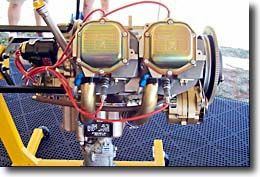Superior Air Parts issued a statement regarding the FAA’s Notice of Proposed Rulemaking on potentially defective crankshafts in some Lycoming engines. The parts were manufactured by Superior under Parts Manufacturer Approval or PMA. This NPRM, which identifies cranks in some 115 engines, is likely to turn into an airworthiness directive.
According to Superior, the NPRM affects Superior-built O-360 and IO-360 engines, and certain Lycoming engines (AEIO-360, IO-360 and O-360). “Unfortunately, we were only informed of the proposed rule two-weeks ago. Since then, we have been in contact with the FAA regarding their findings to fully understand the issue and identify the most likely cause of the failures,” stated Scott Hayes, VP of sales and marketing for Superior Air Parts Inc. “Our engineering team is currently reviewing all of the available information, and once we have determined the actual cause, we can work with the FAA to determine the most logical course of action.”
“All I can say for certain is that it is still just too early to form any type of conclusion about what caused these three crankshafts to fail the way they did,” stated Bill Ross, VP of product support at Superior Air Parts Inc. “We want every one of our customers to know that we put safety ahead of everything and will do everything in our power to find the root cause as soon as possible.”
Superior claims that the affected crankshafts were “all produced by a specific Superior Air Parts vendor between 2012 and 2014, with the following parts numbers: (P/N) SL36500-A20 or P/N SL36500-A31, with serial numbers 82976-01; 82976-02; SP12-0003 through AP12-0089, inclusive; SP13-0034 through SP13-0150, inclusive; or SP14-0151 through SP14-0202, inclusive.” The cranks were in new engines from Superior as well as sold as replacement parts for other engines.
The NPRM stems from the FAA’s recognition of three engine stoppages from March 2017 to October 2018 resulting from crankshaft failure. In the NPRM, the FAA says that it “considered alternatives that may be less burdensome than removing the crankshaft assembly from service, including not taking AD action and requiring periodic inspections of the crankshaft assembly. However, these options are not acceptable because taking no action does not correct this known unsafe condition and the crankshaft assembly cannot be inspected without destroying it. The FAA concluded that there is no acceptable safety alternative to the replacement of the crankshaft assembly.”




































115 engines.
Would the consensus reaction be different if it were 1,150 engines? 11,500 engines?
Would it not in the long run be cheaper for them to just give out 115 new engines and take the old ones back? The tear down labor costs for replacing a crankshaft in quite high. Even if it costs a few bucks more to replace the entire engine the customer good will will overcome any temporary losses to the bottom line.
Agreed. I am not impressed with Superior’s response to this NPRM; It has a “Why is the FAA moving so quick?” tone to it. It should read more like, “We are cooperating 100% with the FAA, and we have already reached out to the other 115 owners to make this right.”
Replacing 115 engines does seem a lot cheaper than the long-term impact something like this could have on Superior’s business.
I thought superior already did this? This from Kit Planes a few days ago: Scott Hayes, VP, Sales and Marketing for Superior Air Parts, Inc., announced today that the company is implementing an immediate and mandatory buy-back of all the Superior Air Parts XP-382 and XP-400 series experimental aircraft engines in the field.
Different issue; different population.